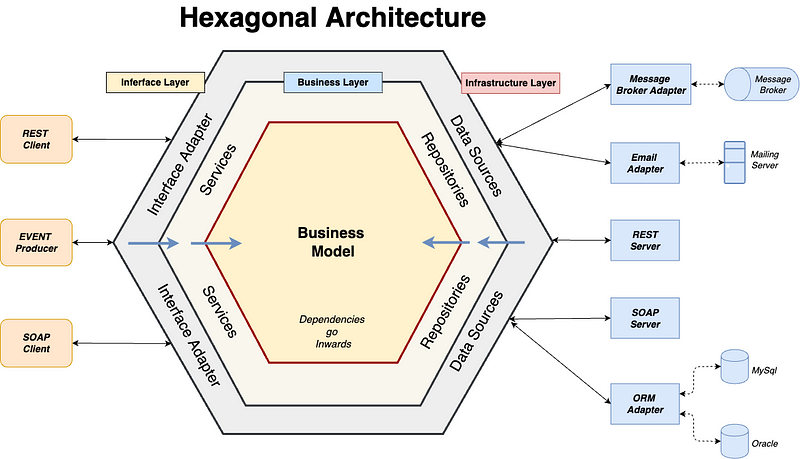What's Hexagonal Architecture?
The Hexagonal Architecture, also known as Ports and Adapters or the Onion Architecture, was introduced by Alistair Cockburn in the early…

The Hexagonal Architecture, also known as Ports and Adapters or the Onion Architecture, was introduced by Alistair Cockburn in the early 2000s as an architectural pattern to create maintainable, adaptable, and easily testable applications.
It is a layered approach that helps decouple an application's core business logic from its dependencies and external concerns.
Components of the Hexagonal Architecture
The Hexagonal Architecture revolves around three primary components:
Domain Model
At the centre of the architecture is the Domain Model, which represents the application's core business logic and entities. It is responsible for implementing the main functionality and rules that the application is built around. The Domain Model should be independent of external concerns such as databases, UI frameworks, or other dependencies.
Ports
Ports are the interfaces that define the communication points between the application's core logic and the external world. They can be divided into two categories:
- Primary or Driving Ports: These ports define the operations that the application exposes to external actors. They represent the use cases or application services that external systems or users initiate—for example, an API interface or a user interface.
- Secondary or Driven Ports: These ports define the operations that the application needs from external services or components. They represent the dependencies or resources required for the application to function, such as databases, third-party APIs, or messaging systems.
Adapters
Adapters are the components that translate the interactions between the external world and the core business logic by implementing the ports. They can be categorized as:
- Primary or Driving Adapters: These adapters convert external inputs, such as user interface events or API calls, into a format that the core logic can understand. Examples include REST API controllers or UI event handlers.
- Secondary or Driven Adapters: These adapters implement secondary ports by providing the required functionality to interact with external services or resources. Examples include database repositories, external API clients, or messaging system clients.
Advantages of the Hexagonal Architecture
The Hexagonal Architecture offers several benefits that can lead to a more maintainable, adaptable, and easily testable application:
Decoupling
The separation of concerns between the domain logic, ports, and adapters ensures that each component can be developed, tested, and evolved independently. This decoupling enables a more modular and flexible architecture.
Testability
The clear boundaries defined by the ports make creating unit and integration tests for each component easy. The core business logic can be tested in isolation from external dependencies, while adapters can be tested with their respective ports.
Adaptability
By defining the communication points through ports, the Hexagonal Architecture makes it easy to swap or update external dependencies without affecting the core business logic. This allows for more seamless integration with new technologies or resources.
Implementing the Hexagonal Architecture
Identify the Domain Model
Begin by identifying the core business logic and entities that represent your application's domain. Keep the domain model independent of any external concerns or dependencies.
Define Ports
Identify the primary and secondary ports required for your application. Define the interfaces for these ports, focusing on the operations that the core logic needs to expose or consume.
Implement Adapters
Create adapters for each port, implementing the required functionality to interact with external systems or resources. Ensure the adapters adhere to the port interfaces, translating the interactions between the external world and the core logic.
Dependency Inversion Principle
Adhere to the Dependency Inversion Principle, which states that high-level modules should not depend on low-level modules; both should depend on abstractions.
This means the core domain model should depend on the port interfaces, and the adapters should implement those interfaces.
This approach minimises dependencies between components, and the architecture remains modular and adaptable.
Organizing Code
Organize your codebase to reflect the separation of concerns and the layered architecture. One possible structure could include separate folders for the domain model, ports, and adapters. This organization will help maintain clarity and ease of navigation in your codebase.
Testing
Leverage the testability of the Hexagonal Architecture by writing unit tests for the domain model and integration tests for the adapters. By isolating the components and testing them independently, you can ensure that the application behaves as expected and is easier to maintain and update.
Conclusion
The Hexagonal Architecture focuses on separating concerns between the core business logic, ports, and adapters, enabling a modular and decoupled structure well-suited for evolving applications and technologies.
Understanding and implementing this pattern in your projects, you can benefit from its many advantages and build more resilient applications to change.
Follow me on Medium, LinkedIn, and Twitter.
All the best,
Luis Soares
CTO | Head of Engineering | Cyber Security | Blockchain Engineer | NFT | Web3 | DeFi | Data Scientist
#hexagonalarchitecture #resilient #decoupling #business #domain #software #architecture #collaborative #collaboration #data #privacy #security #application #softwaredevelopment #softwareengineering #backend



